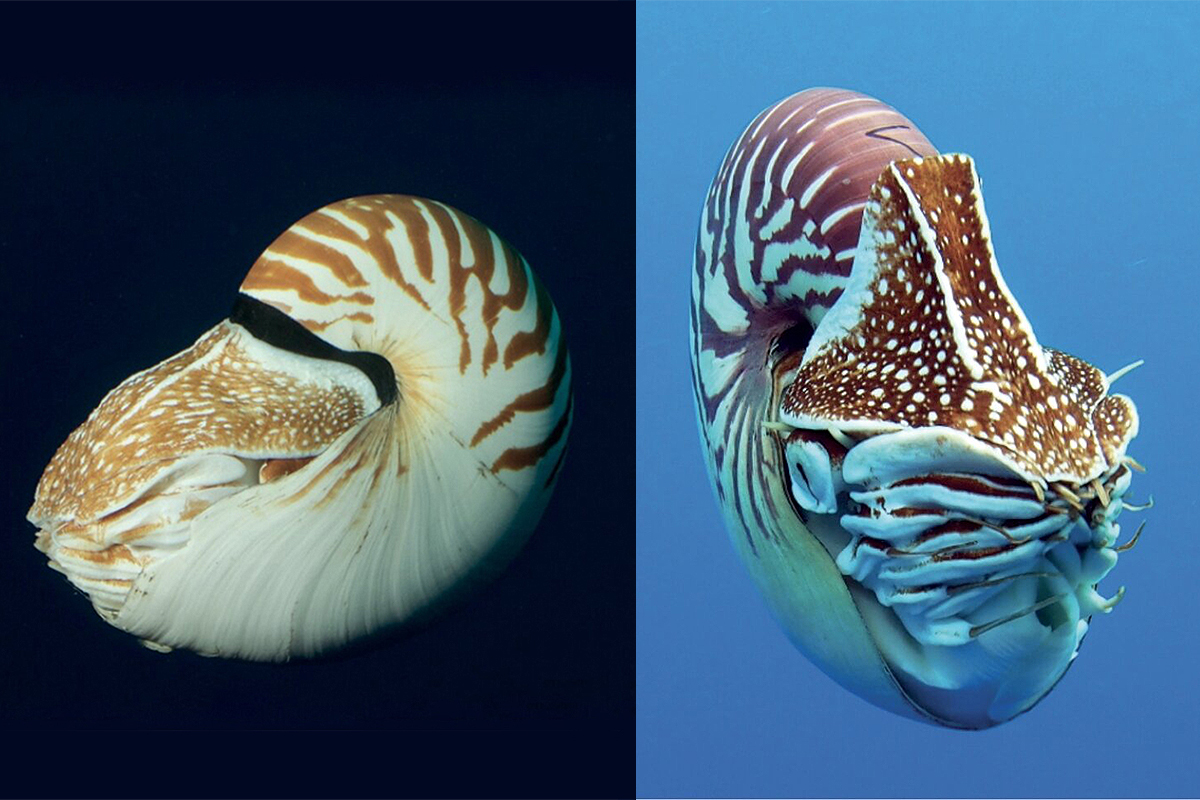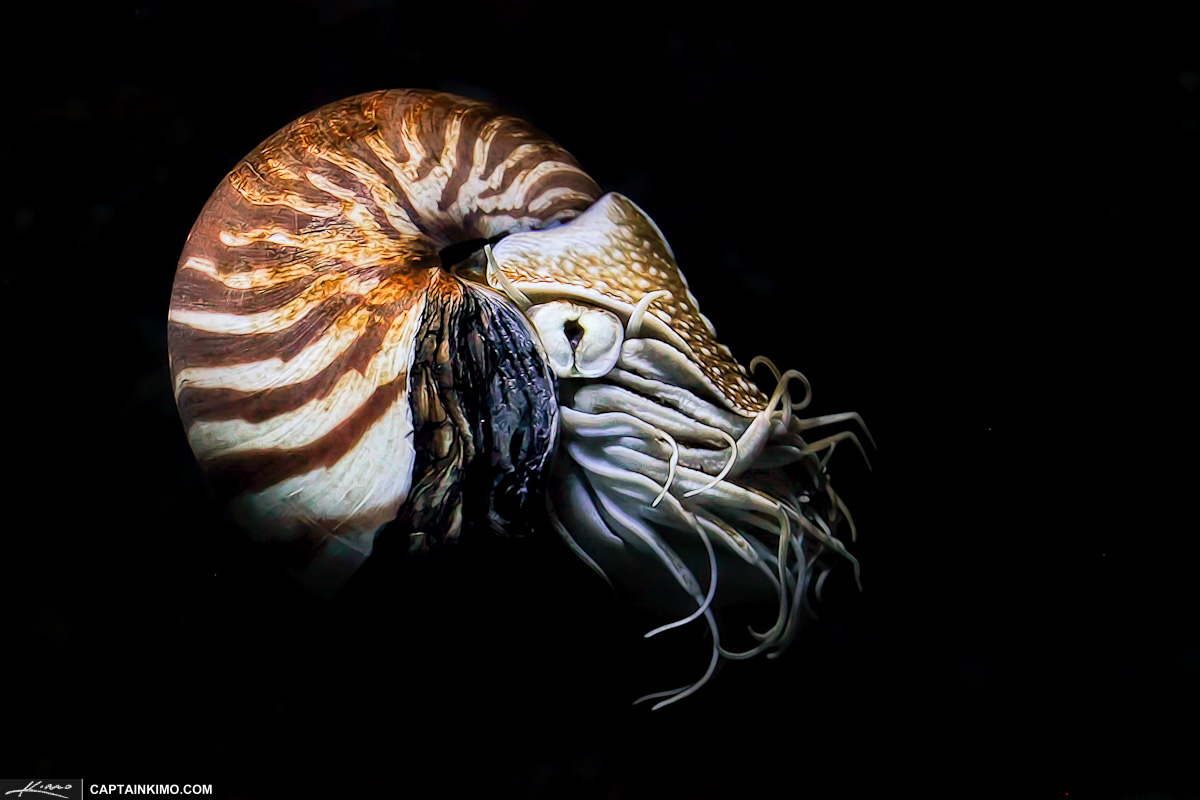- Researchers have described three new species of nautilus found in the Coral Sea and the South Pacific.
- The three species can be differentiated due to genetic structure, shell size and coloration, and geographic location.
- Scientists generally know very little about nautiluses but are working to fill in the data gaps to understand how to protect them.
- Nautiluses are highly threatened by the shell trade, as well as pollution and the impacts of climate change.
During the 16th century, European traders sailed to the Maluku Islands, in what is today eastern Indonesia, seeking spices like nutmeg, cloves and pepper. The traders also found something else of interest: spiral-shaped nautilus shells, once inhabited by deep-sea mollusks fringed with an abundance of tentacles. The shells, patterned with white and brown stripes on the outside and mother-of-pearl on the inside, were shipped back to Europe and sold as curiosities, or turned into opulent goblets embellished with gold.
This fascination with nautiluses has never ceased. Over the centuries, nautilus shells have inspired math, poetry, jewelry and paintings. The word “nautilus” has been used to name ships, luxury watch collections, exercise machines, and even a deep-sea mining company. But despite the nautilus’s ubiquity in our world, scientists know surprisingly little about these animals, whose lineage stretches back 500 million years. For instance, no one has ever seen a nautilus egg in the wild. And while they’re believed to live about 15 years, scientists find it impossible to age a nautilus after its shell is fully developed.
Conservation biologist Gregory Barord calls the nautilus the “most mysterious, well-known animal.”
“If you compare them to the octopus, the amount of information we know about them is virtually nothing,” Barord tells Mongabay. “The most information we had on them was that their populations were declining everywhere because of the shell trade, yet we didn’t know anything about the actual animals.”
Barord, who holds positions at both the conservation group Save the Nautilus and Central Campus in Iowa, has been working with a team of colleagues to unravel the mysteries of these deep-sea cephalopods. In a newly published paper, Barord and others researchers identify three new nautilus species in the Coral Sea and the South Pacific: Nautilus vitiensis, Nautilus samoaensis, and Nautilus vanuatuensis.


The three species look similar, but there are key differences between them in terms of genetic structure, as well as shell size and coloration. Each species is also found in a different geographic location in the Indo-Pacific region: the first in Fiji, the second in American Samoa, and the third in Vanuatu.
“All of these populations are isolated from each other because nautiluses can’t go deeper than 800 meters [2,600 feet],” Barord says. “So if there’s 1000 meter [3,300 ft of] water between two populations, the nautilus is not going to be able to survive that tract, because their shell will implode below 800 meters. We also know that warm surface water temperatures kill nautiluses, so they’re not going to be necessarily swimming at the surface, going from island to island.”
He adds that other geographically separated populations are likely distinct species due to their isolation.
To collect evidence of these newly described species, Barord and his colleagues traveled to various sites in Fiji, American Samoa and Vanuatu, and built large traps out of steel, mesh and chicken wire, baited with raw meat (usually chicken). At dusk, they dropped the traps to a depth of 300 m (980 ft) underwater, then retrieved them the next morning. If everything went to plan, the traps would be filled with nautiluses.
While researchers previously killed nautiluses to study them, Barord and his team used a non-lethal approach. The researchers took special care to keep the nautiluses at a comfortable temperature by placing them in chilled seawater, and took tentacle samples of just a centimeter, or less than half an inch; Barord says this doesn’t hurt the animals. When they returned them to the water, they did something called “nautilus burping,” which involves swimming or scuba diving with them for about 30 m (100 ft) to ensure they don’t have air bubbles trapped in their shells and that they can safely get back to their deep-sea habitat.
Besides the three newly identified species, scientists have formally described six other nautilus species, including the fuzzy nautilus (Allonautilus scrobiculatus) found in the waters around New Guinea. But the researchers say there are likely many more species waiting to be described.
“They’re everywhere out there,” study co-author Peter Ward, a paleobiologist at the University of Washington, tells Mongabay. He says he’s putting together another paper that will describe two additional nautilus species found at Osprey Reef, a seamount off the northern coast of Australia.
“We’re finding that each of these seamounts, which there are so many in the Indo-Pacific, appear to have their own unique nautilus species,” Ward says. “There are four or five seamounts off Australia, only two of which have been sampled, and in each case there is a wholly different species. So these things get isolated easily, they speciate, they become unable to interbreed with other nautiluses. So I think we’ve just barely scratched the surface of how many species there are.”
Besides the identification of new species, scientists are working to produce population estimates of the known species to gain a better understanding of their conservation statuses. While some nautilus populations appear stable or are even increasing due to their predators being overfished, other populations are under threat. For instance, unregulated fishing for nautilus shells in the Philippines has sent some populations into sharp decline, including a population in the Tañon Strait that crashed by 97% in just 16 years. Research has suggested that the best-known species, Nautilus pompilius, might even qualify for “endangered” status on the IUCN Red List due to overfishing if it were to be assessed. At the moment, no nautilus species has yet to be assessed by the IUCN. Nautilus populations in other countries, including Indonesia, New Caledonia and Palau, are also experiencing reductions. But in Fiji, American Samoa and Vanuatu, there are no known nautilus fisheries.

In 2016, nautiluses were listed in Appendix II of CITES, the global convention on the legal wildlife trade, in an effort to regulate the trade of their shells. These shells can sell for up to about $1,000 each.
Fishing isn’t the only threat for nautiluses; they’re also vulnerable to silt pollution from coastal development, as well as the impacts of human-induced climate change. The steady increase in ocean temperatures is forcing nautiluses to go deeper into the ocean to avoid the heat — but there is only so far they can go due to the limitations of their shells. Climate change is also acidifying the water, which makes it harder for nautiluses to produce their signature shells that they need for survival.
“Ocean acidification is far more problematic in warm water, so as warm water moves down deeper, it’s getting more acidic,” Ward says. “Right off Washington state, we have cold water, and already it’s so acidic that the larvae of oysters can’t grow to full size — they die as larvae because they just get eaten up by the acid.”
Barord points out that nautiluses managed to survive “all of these mass extinctions” over the past hundreds of millions of years and have evolved the ability to adapt to changing environments. But will nautiluses be able to survive the impacts of a climate that’s changing at breakneck speed? This question remains unanswered.
Barord says it’s important to learn as much as possible about nautiluses so it’s understood what needs to be done to help protect them — and the identification of new species is an important part of this work.
“We need learn about these organisms before they disappear,” he says, “to hopefully make sure they don’t disappear.”
Banner image: Two of the newly identified nautilus species: Nautilus vitiensis (left) and Nautilus samoaensis (right). Images courtesy of Barord et al.
Elizabeth Claire Alberts is a senior staff writer for Mongabay. Follow her on Twitter @ECAlberts.
Citations:
Barord, G. J., Combosch, D. J., Giribet, G., Landman, N., Lemer, S., Veloso, J., & Ward, P. D. (2023). Three new species of Nautilus Linnaeus, 1758 (Mollusca, Cephalopoda) from the Coral Sea and South Pacific. ZooKeys, 1143, 51-69. doi:10.3897/zookeys.1143.84427
Dunstan, A., Alanis, O., & Marshall, J. (2010). Nautilus pompilius fishing and population decline in the Philippines: A comparison with an unexploited Australian Nautilus population. Fisheries Research, 106(2), 239-247. doi:10.1016/j.fishres.2010.06.015
New species of ‘Tolkien frog’ emerges from Middle Earth of Ecuadoran Andes
